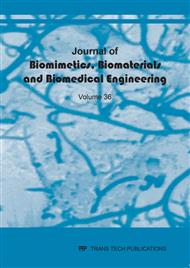[1]
BOXERBAUM A.S, WERK P, QUINN R.D, et al. Design of an autonomous amphibious robot for surf zone operation: Part I mechanical design for multi-mode mobility[C]// Proceedings International Conference on Advanced Intelligent Mechatronics, July 24-28, (2005).
DOI: 10.1109/aim.2005.1511216
Google Scholar
[2]
WANG Guobiao, CHEN Diansheng, etal. The Current Research Status and Development Strategy on Biomimetic Robot[J]. Journal of Mechanical Engineering, 2015, 51(31): 27- 44.
Google Scholar
[3]
Paulson L D. Biomimetics Robot[J]. Computer . 2004, 37(9):48–53.
Google Scholar
[4]
LU Yongxiang. The significance and development of bionics[J]. Scientific Chinese, 2004(4): 22-24.
Google Scholar
[5]
JI Aihong, DAI Zhendong, ZHOU Laishui. Research development of bio-inspired robotics[J]. Robot, 2005, 27(3): 284-288.
Google Scholar
[6]
Seonghun Honga, Changhyun Choc, Hyeongcheol Lee,etal. Joint configuration for physically safe human–robot interaction of serial-chain manipulators[J]. Mechanism and Machine Theory 107 (2017) 246-260.
DOI: 10.1016/j.mechmachtheory.2016.10.002
Google Scholar
[7]
Zhang Yongjun, Yang Lansheng. A study of the mechanism of arms based on bionics [J]. Robot, 1998, 20(1): 20-25.
Google Scholar
[8]
Zhang Liang, Jin Zhenlin. Dimensional Synthesis and Design of a Shoulder Joint for Fruit and Vegetable Harvesting Manipulator [J]. Journal of Software Engineering, 2015, 9(2): 392-400.
DOI: 10.3923/jse.2015.392.400
Google Scholar
[9]
Cui Bingyan, Jin Zhenlin. Statics analysis and parameter design of robot shoulder joint based on orthogonal mechanism[J]. Optica and Precision Engineering, 2011, 19(1): 77-82.
Google Scholar
[10]
Bing-yan Cui, Li-wen Chen, Zhi-jun Wang, etal. Design and Dynamic Analysis of a Novel Biomimetic Robotics Hip Joint[J]. Applied Bionics and Biomechanics, 2015, 1-8.
DOI: 10.1155/2015/145040
Google Scholar
[11]
BY Cui, LW Chen. Analysis of Statics and Design of Structur Parameters for a Bionic Robot Hip Joint [J]. Journal of Biomimetics Biomaterials & Biomedical Engineering, 2015, 22: 03-12.
DOI: 10.4028/www.scientific.net/jbbbe.22.3
Google Scholar
[12]
Chen Liwen, Cui Bingyan, etal. Statics Analysis and Design of the 6-DOF Lower Limb Bionic Leg[J]. Journal of Biomimetics Biomaterials & Biomedical Engineering, 2016, 26: 01-12.
DOI: 10.4028/www.scientific.net/jbbbe.26.1
Google Scholar
[13]
AGRAWAL A,SANGWAN V,BANALA S K,etal. Design of a noval two degree of freedom ankel- foot orhtosis[J]. Journal of Mechanical Design[J].Transactions of the ASME, 2007, 129(11): 1137-1143.
DOI: 10.1115/1.2771231
Google Scholar
[14]
STANISIC M M, GOEHLERC M.Reproducing Human Arm Motion Using a Kinematically Couppled Humanoid Shoulder-elbow Complex[J].Applied Bionics and Biomechanics, 2008, 5(4):175-185.
DOI: 10.1155/2008/507871
Google Scholar
[15]
Erwin-Christian Lovasz, Dan Teodor Mărgineanu, Valentin Ciupe, etal. Design and control solutions for haptic elbow exoskeleton module used in space telerobotics[J]. Mechanism and Machine Theory, 2017, 107 (2017)384–398.
DOI: 10.1016/j.mechmachtheory.2016.08.004
Google Scholar
[16]
Cui Bingyan, Jin Zhenlin. Analysis of statics performance for a novel elbow joint of agricultural robot [J]. Transactions of the CSAE, 2011, 27(3):122-125.
Google Scholar
[17]
Zhou Huijun, Gao feng. Progress in modern institutions [M]. Beijing: higher education press, 2007: 253-298.
Google Scholar
[18]
Gong Jinliang, Zhang Yanpei, Gao Feng. The of paralle mechanism [J]. The Mechanical Engineering of China, 2006, 17(14):1509-1511.
Google Scholar
[19]
Sun Lining, Liu Yu, Zhu Yuhong. Position analysis of a spherical 3-DOF parallel decoupling mechanism for wrist joints [J]. China Mechanical Engineering, 2003, 14(10): 0831-0834.
Google Scholar
[20]
ZENG Daxing, HU Zhitao, HOU Yulei, SU Yonglin. Novel decoupled parallel mechanism for ankle rehabilitation and its optimization [J]. Journal of Mechanical Engineering, 2015, 51(9):001-009.
DOI: 10.3901/jme.2015.09.001
Google Scholar
[21]
HUANG Zhen, ZHAO Yong-sheng, ZHAO Tie-shi. Advanced spatial mechanism [M], China Higher Education Press, Beijing, (2006).
Google Scholar


